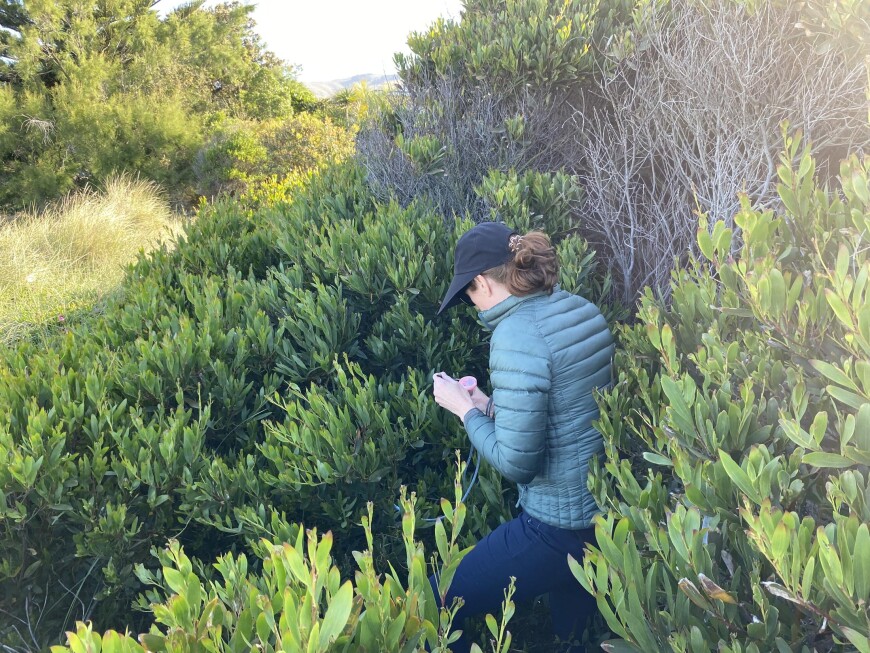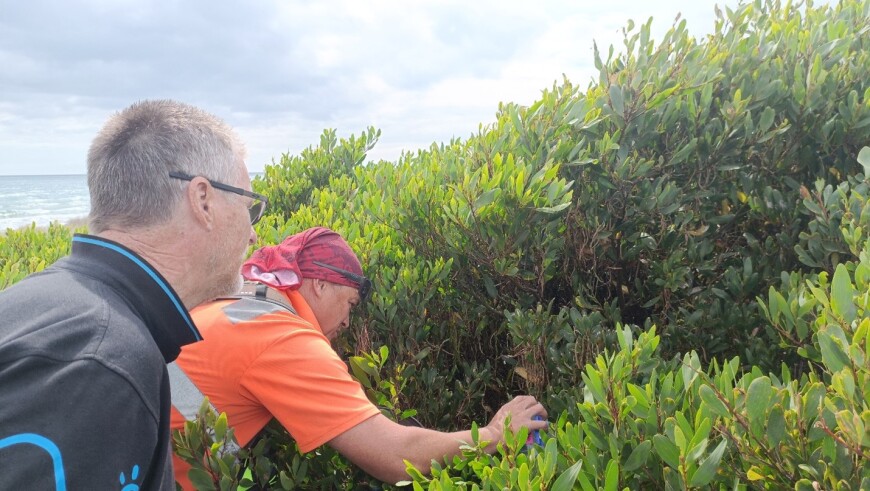A newly established wasp unanimously welcomed
The bud-galling wasp (Trichilogaster acaciaelongifoliae) was released at two sites in the Manawatū-Whanganui Region against Sydney golden wattle (Acacia longifolia) in December 2022 and 2023. We are now excited to report that this agent has successfully established at both sites and numbers are expected to expand quickly. Despite these early promising signs, further efforts were made to import a large consignment of galls infested with immature stages of the wasp in November 2024, allowing us to release over a thousand wasps in different parts of the country.

Image: Angela releasing wasps in Christchurch.
This tiny bud-galling wasp (3–4 mm in length) lays eggs inside the immature flower buds, and sometimes the vegetative buds, of Sydney golden wattle in late spring/early summer. The eggs remain dormant and only start hatching in late winter of the following year. Then, the small larvae feeding inside the buds induce the formation of large growths, called galls, instead of flowers and shoots. This, in turn, reduces the production of seeds and diverts the plant’s resources. In South Africa, where a biological programme for Sydney golden wattle was initiated in the 1980s, the production of galls reportedly weakens the trees to such an extent that they often die under severe attack by this agent. Sydney golden wattle is no longer a threat to the environment and unique biodiversity in South Africa thanks to the introduction of this wasp and a seed-feeding weevil.

Image: imported galls from South Africa.
As part of a collaborative project with Horizons Regional Council (HRC), HRC staff have been monitoring the two release sites at Castlecliff beach in the Whanganui District and Waitārere beach located in the Horowhenua District of Manawatū-Whanganui. Their observations of galls on Sydney golden wattle trees at these two sites in November 2023 were very encouraging and the first early signs that the wasp has successfully established.
This season these sites were monitored again, and higher numbers of galls were found by Robbie Sicely and Abi Wightman, HRC biosecurity officers, who have been closely involved with the project since the introduction of this agent. During a brief search, over a hundred galls were located at a sub-site of the first release site at Castlecliff beach. “This sub-site looks particularly promising!” enthused Robbie, who was in charge of releasing the wasps the previous years and monitoring this Castlecliff beach site. Indeed, even though the adults are short lived (living for only 3–4 days), because the vast majority of them are females due to their parthenogenetic reproduction (whereby females lay fertile eggs without the need for mating), populations have the potential to grow quickly. Each female can lay a few hundred eggs, making this wasp an ideal biocontrol agent.
Following some difficulties with exporting more galls from South Africa in 2023, the decision was made to hand-carry our next shipment. A well-timed trip home for MWLR Science Team Leader Angela Bownes, combined with the support of our collaborator Fiona Impson from the University of Cape Town, were the perfect ingredients to end up with a significant number of galls collected from South Africa in November. After a few hiccups Angela successfully managed to import over 2,000 galls into our containment facility in Lincoln. Due to biosecurity concerns the galls containing the larvae couldn’t be directly released. Instead, they were handed over to MWLR senior technician and project leader Arnaud Cartier to look after them and collect each individual wasp emerging from the imported material. “Luckily, we were able to gather all the required documentation without any significant delays to be able to satisfy MPI, so they could grant us approval to release the wasps from containment and start planning our upcoming releases without compromising the timing of the peak of emergence,” said Arnaud.
The sheer number of galls imported compared to previous years, and a better knowledge of the conditions required to keep the galls healthy, meant that plenty of wasps were successfully released in several different parts of the country. Along with HRC, new regional and district councils such as Environment Canterbury, Tasman District Council and Bay of Plenty Regional Council were very supportive of its introduction, and all welcomed the release of between 150 to 200 females at new sites. In just over a month, MWLR’s biocontrol team were kept busy releasing over a thousand wasps thanks to this third shipment of galls.

Image: Chris McKay (pictured left) and Hayden Murray (right) releasing the bud-galling wasps on Matakana Island.
The very first release in the Bay of Plenty Region took place on Matakana Island in early December, with the support of Ngāi Tuwhiwhia, Ngāi Tamawhariua, Ngāti Tauaiti, Te Whānau a Tauwhao, and Te Ngare, all part of the Ngāi Te Rangi iwi. Matakana Island is accustomed to the use of biocontrol agents. “This will be the third trial we have done here in partnership with BOPRC. There are of course negative and positive aspects when using biocontrol,” said Hayden Murray (Ngāi Te Rangi iwi). “Some of the positives are that they are environmentally friendly and do not add pollutants into the environment. One of the negatives is that it can be a slow process and can take a while to get the desired results. We look forward to seeing the results of this latest release,” he added.
The upcoming years will be interesting to assess the establishment success of these new releases. This would equally be a great opportunity to study the population growth and spread of this new agent in more detail to allow collection and further redistribution to other places, such as Northland, which is in need of help to fight Sydney golden wattle. There is no doubt that expectations are high to control this invasive species of wattle, and promising results will hopefully be achieved in the near future.
This project is funded by the National Biocontrol Collective and the Ministry for Primary Industries’ Sustainable Food, Fibre and Futures Fund (Grant #20095) on multi-weed biocontrol.
Key contact

